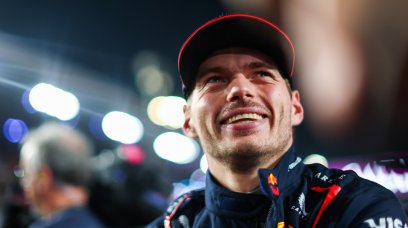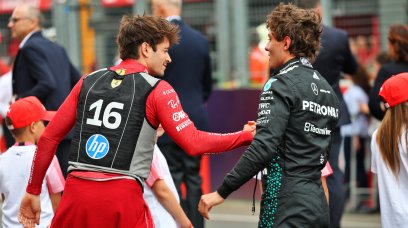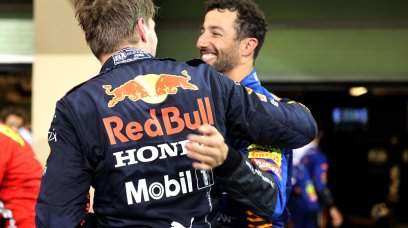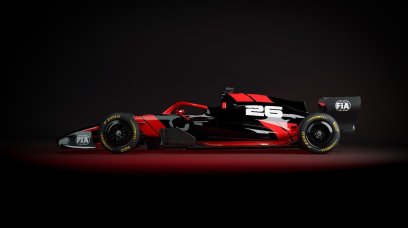The Jeddah Corniche Circuit in Saudi Arabia has only hosted two Formula 1 races but has already imprinted itself onto the consciousness of Grand Prix racing after memorable events. In the inaugural 2021 event, title rivals Max Verstappen and Lewis Hamilton memorably collided when the former seemingly brake-tested the latter into Turn 27 when told by the FIA to cede position after a Turn 1 incident earlier that lap. Three months later, Verstappen and Charles Leclerc embarked on a game of DRS chicken at the same point in the lap - with the Red Bull man winning out in the duel to claim his first win of what would be a title-winning season. The track is somewhat unique in F1, a 27-turn blast on the Red Sea coast with only the bravest drivers flat out all the way from Turn 16 through the notorious Turn 22/23 cink before hitting the brakes for the final hairpin. In March's race, Leclerc set a fastest lap of 1m:31.634. That's a 232.556 km/h (150.717 mph) average speed on a street circuit. Some argued the track was too fast, with too little visibility - especially through the sweeping first sector. But as RacingNews365.com exclusively discovered on a recent trip to the Jeddah Corniche Circuit, changes are being made voluntarily to improve all the all-round challenge.
Unintended consequences
One of the immediate fears upon the initial visit to Jeddah - "the fastest built circuit" according to Hermann Tilke's eponymous company who were involved - was that in the first sector, the lack of visibility could prove a problem, especially at the start and on Safety Car restarts. As it turned out, on one 2021 restart, a pile-up caused an unsighted Nikita Mazepin to run into the back of George Russell who had been forced to almost stopping after the incident ahead. To prevent this potentially happening again, for 2022 the walls were moved back to improve visibility, but the track bosses believe moving them any further could have caused unintended consequences. "It was interesting, the dynamic when Formula 1 and the FIA were here," explains Track Operations Manager Gary Palmer. "Because you almost had the FIA saying: 'It's a street circuit, it's not designed to have permanent lines of sight on every corner.' "One of the arguments against changing the lines of sight in every corner, is because the circuit is fast already, if we give drivers more visibility of lines and corners, it's going to make it even quicker. "We actually pushed back on a lot of the [about 40] changes requested. "It's a fine line to tread between adapting it to what the drivers totally want versus the demands for a street circuit. "There's been a lot of work and investment made to make this circuit as perfect as it can be."
Mick Schumacher's crash prompts change
The changes around the track's 6.174km (3.836 miles) vary in severity from minor to extensive re-profiling work at certain points. Throughout Sector 1, the walls have been largely shifted back, but the white lines marking the track limits will not be affected. It is only a visual effect designed to improve line of sight for the drivers. A change here was requested by the FIA as sharp edges on concrete blocks used to build the track were deemed dangerous - rounder, flatter blocks have now been installed. The first major work comes at the Turn 10/11/12 complex - the scene of Mick Schumacher's accident in 2022 qualifying. Haas driver Schumacher went wide coming out of Turn 9 and rode up onto the kerb, spitting him into the wall on the inside, before coming to rest. Carlos Sainz Jr also suffered a high-speed spins in this section in 2021 after emerging from the challenging sweepers. However, it was also a case of modifications to meet the new demands of the 2022 breed of cars - which need to run low to the track to create downforce. "[In] Turn 10 , we moved the wall a little bit to the left side, again to give the driver more visibility to Turns 11 and 12 ," says Palmer's equivalent from Tilke's company, site manager Benjamin Hoffman. "It is where Mick Schumacher crashed and it gives drivers a bit more visibility ahead [through the complex and down to the unchanged Turn 13. ]"
Turns 22 and 23
After the drivers negotiate the top end of the circuit, they are presented with the blast along the back-straight from the exit of Turn 17 through to the fast, sweeping chicane of Turns 22 and 23. In 2021, Schumacher and Leclerc both misjudged the corner, suffering heavy damage after hitting the Tecpro barriers. It is the section of the track that has received the greatest amount of re-profiling. "The major part is that at Turns 22 and 23, we will be reducing the speed of the car by approximately 50 kph - 31mph," explains Hoffman. "It's to make them a little bit slower running through the whole complex, so we've tightened the whole area up. It was kind of a bigger 'S', but we are squeezing it. "The current downforce levels of these cars is ridiculously fast in high speed corners. "When we designed the circuit, we couldn't imagine how crazy these new generation of cars are in the high speed. "It is also creating a new braking opportunity. "The speed profile of the corner will be similar to Turn 16, because now they were running nearly 200km/h through the apex of Turn 22 , but we're going to aim for the same speed profile as Turn 16 - a little slower but still very flowing. "The DNA of the track doesn't change - it's just going back a little bit to adapt to the current cars.
Rumble strips to help track position
One of F1's perennial problems come from drivers struggling to stay within track limits - often finding more lap-time if they drift over the lines marking the edge of the circuit. With drivers having blindspots of up to 30 metres around the car, it can sometimes be tricky to judge track limits - so the Jeddah circuit bosses decided to give drivers "feedback" on their car positioning. To combat the problem, the Jeddah circuit is using a relatively simple idea: rumble strips. Using adhesive mats of 2.5mm thickness, so as not "shake the teeth from their head," the idea has already been experimented with in Singapore on the exit of Turn 5.
However, Jeddah bosses are keen not to go overboard. "You attach them with heat, but a Formula 1 car also creates heat," they pointed out to RN365. "So you can dislodge them with heat - that is the risk. That is why we are being very careful in not just doing something completely new and throwing it everywhere on the circuit. That wouldn't work." The rumble strips are in place at corners such as Turns 2,3 as well as Turns 14 and 19 - wherever it is possible to cut corners. The drainage system around the circuit has also been improved by using 'slot drains', which collect water underground so it cannot be drawn back onto the circuit.
Future of Jeddah
The original road-map for F1 in Saudi Arabia was to have a two-year spell at Jeddah Corniche Circuit , before upping sticks to Qaddiya - a spectacular theme park situated outside the capital, Riyadh. However, development of the proposed site fell behind due to COVID, with the coastal circuit set to remain the home of the Saudi Arabian Grand Prix for the foreseeable future. It is a situation bosses are keen to make the most of. A short circuit has been created to host World Touring Car races, by adding a loop which shaves the distance to about three kilometres - half the Grand Prix layout of 6.174 km (3.836 miles). The eventual goal is to create a venue similar to Silverstone in Great Britain. As well as motor racing, Silverstone is now also a commercial hub where meetings, functions, events, and track days are staged during the 11 months and three weeks of the year F1 is not in town. Despite the extensive work that has taken place in preparation for the 2023 Grand Prix, one thing will remain constant at Jeddah: the lap-time. It is a fine balancing act, but although steps have been taken to slow the cars, through Turns 22 and 23, this is compensated for by the speeding up in Sector 1. The 1m:30s lap-time means Jeddah Corniche Circuit will remain F1's fastest street circuit.
Most read







